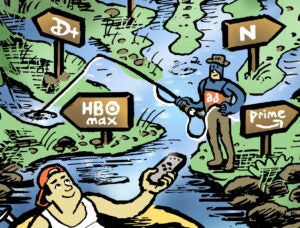 “Data-Driven Thinking” is written by members of the media community and contains fresh ideas on the digital revolution in media.
“Data-Driven Thinking” is written by members of the media community and contains fresh ideas on the digital revolution in media.
Today’s column is written by Michael Oiknine, CEO at Apsalar.
The mobile app industry is again abuzz with news that apps are being rejected from Apple’s app store for accessing the Identifier For Advertising (IDFA) without serving ads inside their apps. In June 2012, I wrote about why the IDFA, which had just been introduced, was a better alternative to the UDID for the mobile advertising industry.
Last week, Apple pulled another wild card, leaving the mobile industry in disbelief. It reveals what I believe to be a shortsighted strategy that will impact different apps and the industry as a whole. It’s clear to me that the industry can no longer rely on Apple. Let me explain.
So What’s Happening?
The IDFA is a device identifier that is used by many providers for various reasons. Mobile ad platforms use the IDFA to measure user behavior in mobile apps. Additionally, the IDFA is the shared identifier between an ad network and attribution vendors, which allows them to report which networks delivered a particular app download.
Based on Apple’s recent actions, an iOS app will be rejected if that app collects the IDFA of a device and does not serve ads. Conversely, if an app serves ads, that app should see no issues with their next submission to the Apple store, whether it accesses the IDFA or not.
Apple’s decision is shortsighted. While the rejected apps may not run ads inside their app, they are most likely purchasing ads on third-party apps in order to acquire users. These ad buys have contributed to the explosion of mobile advertising and the iOS advertising ecosystem.
Unfortunately, without accessing the IDFA currently used for attribution, marketers can’t accurately measure the performance of their advertising campaigns. As a result, advertising spending will be cut, which in turn will reduce the value of the IDFA going forward to an ID that advertisers will only use for frequency capping across ad networks and ad exchanges. Maybe Apple should rename it IDFFC (Identifier For Frequency Capping)?
The decision is taking the industry by surprise given that the adoption of the IDFA, which was initially presented as Apple’s blessed alternative to the UDID, has been pervasive and resulted in the growth of Apple’s own business. EMarketer estimates that in 2014, US mobile ad spending will total $15 billion, of which $7 billion will be spent on display, with the rest going to search. Out of this $7 billion, Facebook alone will contribute $2 billion. But all Facebook mobile measurement partners rely exclusively on the IDFA to determine downloads attributable to Facebook. As of today, Facebook and other big players, such as Twitter, need an answer on this issue, as this could jeopardize billions of dollars in their ad revenues
What Are Apple’s Motivations?
Honestly, no one but Apple really knows. While the press will offer a variety of explanations, I believe that Apple wants to abandon a deterministic user identifier that could be used by all industry players for targeting that is both responsible and irresponsible. This could turn into a big liability for Apple. The mobile advertising industry experienced 135% growth in 2013, according to eMarketer, and will grow 60% in 2015 and 45% in 2016.
For the mobile advertising industry to continue growing at this fast pace, it will use techniques like profiling and targeting based on past behaviors. Unfortunately, while we expect most industry players to behave responsibly when it comes to users’ behavioral data, online advertising experience has showed us that poor and unethical data-management practices will occur. And when that happens, the US government will obviously start at the top and target the one company that both controls the iOS platform and that sanctioned a deterministic ID to identify users in order to collect and build knowledge on them. That is probably too much to bear for a hardware company that has consistently felt uncomfortable with the advertising business.
What’s The Industry To Do?
The mobile advertising industry now needs to solve two practical problems on iOS posed by Apple’s recent actions: attribution and targeting.
But before evaluating solutions to these problems, one thing should be clear. The industry cannot rely on Apple anymore. It should not expect Apple to provide either tools or guidance. Quite frankly, the industry got burned twice now (UDID in 2012 and IDFA in 2014) and, in my opinion, it would be a mistake to think that the solution will come from Apple.
The industry already offers digital fingerprinting as a solution to the attribution problem. While fingerprinting is less accurate than the IDFA-based method, it directionally gives the advertiser an understanding of their campaign performance. I expect analytics vendors to perfect their attribution solutions by investing in data science R&D in the next few months.
Sophisticated marketing analytics tools will also emerge to give marketers actual insights as verticals like retail, travel and financial services demand top-notch performance analysis that goes beyond attributing a download to the last-touched ad network. For these traditional marketers, the last-click attribution model of today will simply not cut it. They will require causal approaches to attribution that can answer questions like, “How much new revenue can I get from specific spending and why?” Expect providers to deliver statistical methods for finding causality in correlated attribution data.
Targeting, including retargeting, will also be solved with a probabilistic approach to identify, and build knowledge on, a user on a mobile device. There is no way around it. The time of deterministic user identification is now over on iOS. This is no different than the challenges faced by the online industry when cookies became volatile due to better browser-based user protection and consumer awareness.
There are other issues beyond attribution and targeting to be addressed, including limiting the collection of PII, making consumers aware when they are being tracked and targeted, and giving consumers a choice to opt out of behavioral advertising. These issues must now be addressed by the industry as a whole, without Apple’s input. It’s up to us to develop the mobile audience measurement and advertising ecosystem in a responsible way.
Follow Michael Oiknine (@moiknine), Apsalar (@apsalarinc) and AdExchanger (@adexchanger) on Twitter.













